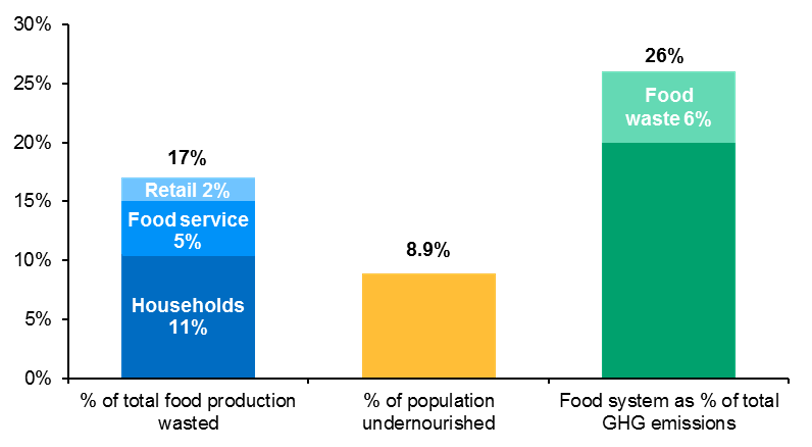Written by: Meera Pandit
The coexistence of food waste and world hunger reflects a classic market failure. About 17% of food goes to waste globally, and yet an estimated 690 million people (8.9% of the world population) are undernourished. Not only does this represent a significant mismatch, but also significant greenhouse gas emissions are generated in the process. The global food system is responsible for 26% of annual global greenhouse gas emissions, with about 6% coming from food waste alone, and agriculture accounting for the majority of the rest. This creates an unfortunate chain reaction: emissions exacerbate climate change, which contributes to more extreme weather like floods and droughts, which could cause further food shortages and spikes in food prices. Changes in climate over time can also depress crop yields. Together, this would make access to adequate food even more challenging for millions around the world.
Similarly, water scarcity is a growing challenge, with global water supply declining relative to increasing demand. Agriculture accounts for 70% of annual fresh water usage globally, and about half of the withdrawals come from sources under stress. Global food production is expected to need to increase by 50% by 2050 as the global population grows, exacerbating challenges for both the global food and water system and global warming more broadly. Clearly, the agricultural industry and food supply chain are ripe for innovation.
Encouragingly, this innovation can span advancements that are not just good for the planet but can be good for business. These solutions include more efficient agricultural techniques and technologies, better waste and water management, sustainable fertilizers, alternative meats, and improved supply chain practices for processing, packaging, transporting and storing. McKinsey highlights agriculture as one of the five key industries that could attract significant investment in climate technology over the next few years, potentially garnering $400-600 billion by 2025.
For investors, this presents opportunities in the companies that are innovating and creating solutions, such as Deere & Co and Evoqua.
Deere & Co, a leading agricultural manufacturer, is uniquely positioned to advance farming productivity. Its ExactEmerge planter technology allows for precise seed placement at double the speed, reducing waste and providing optimal crop growth. The new model X Series Combine will average 45% more harvesting capacity across crops using 20% less fuel. All told, a single customer utilizing six new technologies can avoid emissions over the course of a production cycle equivalent to nearly 1 million passenger car miles driven per year. The same customer may also reduce their input costs by almost 10% and realize $260k in value through both inputs cost savings and increased yield outcomes.
Evoqua, a leading provider of water and wastewater treatment solutions, enables industrial and municipal customers to use water more efficiently and sustainably. Evoqua combines filtration and disinfection in the cooling water systems for data centers, which can reduce water waste by up to 40%, increase energy efficiency by up 10% and decrease maintenance costs up to 50%. The company transforms approximately 100 billion gallons of water every day, which is over 4.5 times the amount of water flowing over Niagara Falls every single day.
These companies are among the holdings of J.P. Morgan’s Climate Change Solutions ETF (NYSE:TEMP). An actively managed sustainable fund. The securities highlighted above have been selected based on their significance and are shown for illustrative purposes only. They are not recommendations.
Food waste, undernourishment, and emissions
Percent

Related: Transparency Could Be Better ESG Mousetrap
Source: Food and Agriculture Organization of the United Nations, U.N. Environmental Program, Our World in Data, J.P. Morgan Asset Management. Share of total global food production wasted from U.N. Environmental Program’s Food Waste Index 2021. Food waste as a share of total greenhouse gas emissions from Our World in Data based on study from Joseph Poore and Thomas Nemecek, “Reducing food’s environmental impacts through producers and consumers” (2018). Share of global population undernourished from “The State of Food Security and Nutrition Around the World in 2020.” Data are as of February 17, 2022.
